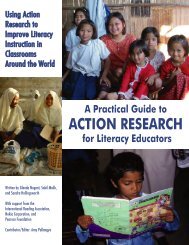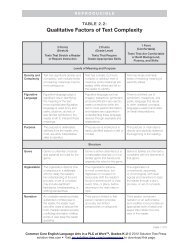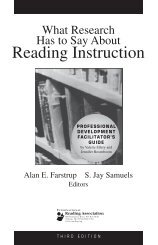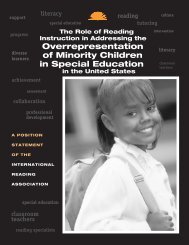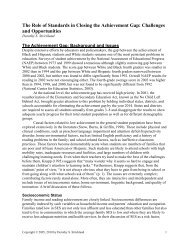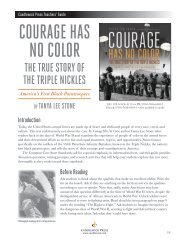New Literacies and 21st-Century Technologies position statement
New Literacies and 21st-Century Technologies position statement
New Literacies and 21st-Century Technologies position statement
Create successful ePaper yourself
Turn your PDF publications into a flip-book with our unique Google optimized e-Paper software.
instruction<br />
teachers<br />
coaching<br />
modeling<br />
observing<br />
<strong>New</strong><br />
<strong>Literacies</strong><br />
<strong>and</strong><br />
<strong>Technologies</strong><br />
home<br />
training<br />
teachers<br />
reading<br />
coaches<br />
reading<br />
<strong>21st</strong>-<br />
<strong>Century</strong><br />
children<br />
assessment<br />
specialists<br />
instruction<br />
involvement<br />
A POSITION<br />
STATEMENT<br />
OF THE<br />
INTERNATIONAL<br />
READING<br />
st<strong>and</strong>ards<br />
leadership<br />
ASSOCIATION<br />
community<br />
professional development
To become fully literate in today’s world, students must become proficient<br />
in the new literacies of <strong>21st</strong>-century technologies. As a result, literacy<br />
educators have a responsibility to effectively integrate these new technologies<br />
into the curriculum, preparing students for the literacy future they deserve.<br />
The Internet <strong>and</strong> other forms of information <strong>and</strong><br />
communication technologies (ICTs) are redefining the<br />
nature of reading, writing, <strong>and</strong> communication. These ICTs<br />
will continue to change in the years ahead, requiring<br />
continuously new literacies to successfully exploit their<br />
potentials. Although many new ICTs will emerge in the<br />
future, those that are common in the lives of our students<br />
include search engines, webpages, e-mail, instant<br />
messaging (IM), blogs, podcasts, e-books, wikis, nings,<br />
YouTube, video, <strong>and</strong> many more. <strong>New</strong> literacy skills <strong>and</strong><br />
practices are required by each new ICT as it emerges <strong>and</strong><br />
evolves.<br />
Literacy educators have a responsibility to integrate<br />
these new literacies into the curriculum to prepare students<br />
for successful civic participation in a global environment.<br />
The International Reading Association believes that<br />
students have the right to the following:<br />
• Teachers who use ICTs skillfully for teaching <strong>and</strong> learning<br />
effectively<br />
• Peers who use ICTs responsibly <strong>and</strong> actively share<br />
effective strategies applied to a range of literacy purposes<br />
<strong>and</strong> settings<br />
• A literacy curriculum that offers opportunities to<br />
collaboratively read, share, <strong>and</strong> create content with peers<br />
from around the world<br />
• Literacy instruction that embeds critical <strong>and</strong> culturally<br />
sensitive thinking into print <strong>and</strong> digital literacy practices<br />
• State reading <strong>and</strong> writing st<strong>and</strong>ards that include new<br />
literacies<br />
• State reading <strong>and</strong> writing assessments that include new<br />
literacies<br />
• School leaders <strong>and</strong> policymakers committed to<br />
advocating the use of ICTs for teaching <strong>and</strong> learning<br />
• Equal access to ICTs for all classrooms <strong>and</strong> all students<br />
Exp<strong>and</strong>ing Our Conception<br />
of Literacy<br />
There is extensive debate about what new literacies are—<br />
the term is used to mean many different things by many<br />
different people. However, there are at least four common<br />
elements that apply to nearly all of the current perspectives<br />
being used to inform the broader dimensions of new<br />
literacies research (Coiro, Knobel, Lankshear, & Leu,<br />
2008): (1) The Internet <strong>and</strong> other ICTs require new social<br />
practices, skills, strategies, <strong>and</strong> dis<strong>position</strong>s for their<br />
effective use; (2) new literacies are central to full civic,<br />
economic, <strong>and</strong> personal participation in a global<br />
community; (3) new literacies rapidly change as defining<br />
technologies change; <strong>and</strong> (4) new literacies are multiple,<br />
multimodal, <strong>and</strong> multifaceted; thus, they benefit from<br />
multiple lenses seeking to underst<strong>and</strong> how to better<br />
support our students in a digital age.<br />
The changes taking place to literacy have been noted<br />
by many in our field (see Alvermann, 2008; Coiro et al.,<br />
2008; Lankshear & Knobel, 2003; Leu, 2007; McKenna,<br />
Labbo, Kieffer, & Reinking, 2006). Additional changes are<br />
taking place to literacy instruction (see Beach & O’Brien,<br />
2008; Callow, 2008; Grisham & Wolsey, 2009; Jolls,<br />
2008; Leu et al., 2008; Merchant, 2008). All of this work<br />
points to the fact that traditional definitions of reading,<br />
writing, <strong>and</strong> communication, <strong>and</strong> traditional definitions of<br />
best practice instruction—derived from a long tradition of<br />
book <strong>and</strong> other print media—are insufficient in the <strong>21st</strong><br />
century.<br />
Although there are multiple ways to view the changes<br />
in literacy <strong>and</strong> communication emerging from new<br />
technologies (Labbo & Reinking, 1999), it is not possible to<br />
ignore them. We need only to consider the experience of<br />
students who graduate from secondary school this year to<br />
see how literacy is changing their experiences at school<br />
<strong>and</strong> in their everyday lives. Graduates began their school<br />
career being taught the literacies of paper, pencil, <strong>and</strong> book<br />
technologies. Many will finish their secondary school<br />
careers familiar with the new literacies dem<strong>and</strong>ed by a<br />
wide variety of ICTs: wikis, blogs, avatars, podcasts, mobile<br />
technologies, <strong>and</strong> many others unimagined at the beginning<br />
of their schooling.<br />
Because of rapid changes in technology, it is likely that<br />
students who begin school this year will experience even<br />
more profound changes in their literacy journeys. Changes<br />
to literacy are defined by regular <strong>and</strong> continuous change<br />
(Leu, Kinzer, Coiro, & Cammack, 2004). Thus, the new<br />
literacies of today will be replaced by even newer literacies<br />
tomorrow as new ICTs continuously emerge among a more<br />
globalized community of learners. In addition, the changes<br />
to literacy are taking place with breakneck speed. Finally,<br />
networked communication technologies such as the<br />
Internet provide the most powerful capabilities for<br />
information <strong>and</strong> communication we have ever seen,<br />
permitting access to people <strong>and</strong> information in ways <strong>and</strong> at<br />
speeds never before possible. Such changes have<br />
important implications for instruction, assessment,<br />
professional development, <strong>and</strong> research. The literacy<br />
community needs to quickly turn its attention to these<br />
profound changes.
The Internet Is Rapidly Entering<br />
Nearly Every Classroom in<br />
Developed Nations Around the<br />
World<br />
The Internet <strong>and</strong> other technologies have proven to be<br />
powerful new tools in the classroom as nations seek to<br />
prepare children for their future in an information age.<br />
Nations such as Australia, Finl<strong>and</strong>, Irel<strong>and</strong>, <strong>New</strong> Zeal<strong>and</strong>,<br />
the United Kingdom, the United States, <strong>and</strong> others are<br />
developing public policies to ensure that classrooms have a<br />
computer connected to the Internet, appropriate software,<br />
ICTs integrated into the curriculum, <strong>and</strong> teachers prepared<br />
for the effective integration of these new technologies into<br />
the classroom. Developments such as these dem<strong>and</strong> from<br />
us a vision that includes the integration of new literacies<br />
within the literacy curriculum.<br />
Equity of Access to ICTs Will<br />
Ensure Literacy Opportunities<br />
for Children Around the World<br />
In many countries, classrooms in wealthier schools have<br />
better technology resources than those in poorer schools.<br />
Continuation of this trend in societies that profess<br />
egalitarian ideals presents an important threat to these<br />
societies’ long-term political stability. The problem is even<br />
greater in developing nations, where classroom Internet<br />
access is only a dream. Will this lead to a widening gulf<br />
between haves <strong>and</strong> have-nots around access to information<br />
afforded different nations? It is essential that literacy<br />
educators <strong>and</strong> others support equal access to information<br />
technologies for all students to ensure that each student<br />
has equal access to life’s opportunities.<br />
Providing Adequate Education<br />
<strong>and</strong> Staff Development Will<br />
Ensure That Each Teacher Is<br />
Prepared to Effectively<br />
Integrate <strong>New</strong> <strong>Literacies</strong> Into<br />
the Curriculum<br />
Professional development is also integral to the changes<br />
that are essential in this area. We must begin to develop<br />
new models of professional development that use the new<br />
online tools <strong>and</strong> resources we expect teachers to use in<br />
their classrooms. Simply making new technologies available<br />
in classrooms is insufficient. School leaders need to<br />
maximize the educational return on the investment that<br />
technology offers by supporting long-term job-embedded<br />
professional development that is personally relevant,<br />
actively engaging, <strong>and</strong> cognizant of the developmental<br />
process through which teachers integrate technology in<br />
their classrooms (Apple, 1995; Garry & Graham, 2004).<br />
Teacher Education Programs<br />
Can Play a Critical Role in<br />
Preparing Teachers to Use <strong>New</strong><br />
<strong>Technologies</strong> for Instruction<br />
<strong>New</strong> teachers should participate in technology-based<br />
planning <strong>and</strong> teaching to meet their students’ academic<br />
needs in all content areas (Bruce, 2004; Grisham & Wolsey,<br />
2009). State <strong>and</strong> national st<strong>and</strong>ards for technology should<br />
infuse all components of teacher preparation so that new<br />
teachers are ready to teach with technology available to<br />
them in their classrooms <strong>and</strong> schools. Teacher preparation<br />
programs must prepare teachers to use technology to<br />
motivate students, bridge the gap between students’ social<br />
<strong>and</strong> academic uses of technology, <strong>and</strong>, in many cases,<br />
provide access to technology for their students. Induction<br />
<strong>and</strong> professional development programs should infuse ICTs<br />
to ensure that teachers use new literacies for instruction.<br />
Universities must embed ICTs strategically in graduate<br />
programs for teachers.<br />
Creative Initiatives to Increase<br />
Access, Provide Professional<br />
Development, <strong>and</strong> Enhance<br />
Teacher Education Should Be<br />
Supported by Professional<br />
Literacy Organizations<br />
The International Reading Association is committed to<br />
conducting <strong>and</strong> supporting professional development for<br />
teachers through both traditional methods <strong>and</strong> the most<br />
innovative ICTs available. The Association encourages all<br />
professional literacy organizations to work separately <strong>and</strong><br />
collaboratively to generate support for open <strong>and</strong> free access<br />
to technology for teachers <strong>and</strong> students.<br />
We Must Pay Particular<br />
Attention to Developing the<br />
Critical <strong>Literacies</strong> These <strong>New</strong><br />
<strong>Technologies</strong> Dem<strong>and</strong><br />
Information is widely available from people who have strong<br />
political, economic, religious, or ideological stances that<br />
profoundly influence the nature of the information they<br />
present to others. As a result, we must assist students to<br />
become critical consumers <strong>and</strong> informed creators of<br />
information in these new online contexts (Alvermann, 2008;<br />
Fabos, 2004; Stevens & Bean, 2007) by providing<br />
instruction in how to critically evaluate the relevancy,<br />
accuracy, reliability, <strong>and</strong> perspective of information created<br />
for a range of purposes <strong>and</strong> audiences.<br />
An Intensive Program of<br />
Research on Literacy <strong>and</strong><br />
Technology Issues Will Enable<br />
Us to Better Underst<strong>and</strong> the<br />
Rapid Changes Taking Place in<br />
the Nature of Literacy <strong>and</strong><br />
Literacy Instruction<br />
Although research in literacy <strong>and</strong> technology integration is<br />
gradually beginning to emerge (see Coiro et al., 2008;<br />
McKenna et al., 2006), the paucity of hard data in this area<br />
remains all too obvious. The task is so large, involves<br />
changes to literacy in such profound ways, <strong>and</strong> must be<br />
accomplished so quickly that all literacy researchers need to<br />
consider how they might contribute. They should consider<br />
bringing their special area of expertise to the study of<br />
literacy within the context of ICTs to address the many new<br />
questions that face us.
Public Policy Debates on<br />
Reading Must Begin to Attend<br />
to the Profound Changes<br />
Taking Place to the<br />
<strong>Technologies</strong> of Literacy<br />
As public policies are developed, defining reading solely<br />
around book technologies will shortchange our students.<br />
Proficiency at effectively using the new literacies of<br />
networked information technologies has become critical to<br />
our students’ success in the workplace <strong>and</strong> in their daily<br />
lives. Public policy leaders must be informed about the<br />
changes taking place in reading so that thoughtful policies<br />
may be developed to prepare children for the literacy<br />
dem<strong>and</strong>s of their future.<br />
Our Responsibilities<br />
What can we do to make sure that students are prepared<br />
for their literacy future? The International Reading<br />
Association recommends the following:<br />
Teachers<br />
• Take full advantage of professional development<br />
opportunities to explore new instructional strategies <strong>and</strong><br />
resources that effectively use ICTs in the classroom.<br />
• Explore new instructional models for integrating the<br />
Internet <strong>and</strong> other ICTs as part of literacy instruction.<br />
• Provide equal opportunity <strong>and</strong> access for all students to<br />
use ICTs that foster <strong>and</strong> improve learning.<br />
• Read professional publications on a regular basis to keep<br />
up with current research <strong>and</strong> best practices for using<br />
technology in instruction to enhance students’ literacy<br />
learning.<br />
Parents<br />
• Inquire as to how your district <strong>and</strong> school integrates the<br />
Internet <strong>and</strong> other ICTs into the reading <strong>and</strong> writing<br />
curriculum.<br />
• Support district initiatives to provide up-to-date<br />
technology resources <strong>and</strong> professional development in<br />
the effective use of ICTs.<br />
• Join children in exploring age-appropriate websites <strong>and</strong><br />
social networking opportunities to better underst<strong>and</strong> the<br />
new experiences that shape their lives at home <strong>and</strong> in<br />
schools.<br />
• Participate in local school-based online networks that<br />
share <strong>and</strong> exchange resources with parents.<br />
Teacher educators<br />
• Provide professional development <strong>and</strong> support to teacher<br />
education faculty to incorporate technology into their<br />
courses across the curriculum.<br />
• Ensure that teacher preparation programs provide<br />
distributed practice to teacher c<strong>and</strong>idates in technologyenriched<br />
teaching throughout their teacher preparation.<br />
• Assist induction programs for new teachers to provide<br />
applications of instructional technology in the classroom.<br />
• Support graduate teacher education for practicing<br />
teachers that incorporates technology into all professional<br />
development at colleges <strong>and</strong> universities.<br />
• Provide at all levels interest-driven, inquiry projects with<br />
opportunities for exploration <strong>and</strong> expansion of teachers’<br />
knowledge base.<br />
School administrators<br />
• Ensure that sufficient time <strong>and</strong> 30% of your district’s<br />
technology budget are devoted to professional<br />
development in the effective use of ICTs in the<br />
classroom.<br />
• Encourage teachers <strong>and</strong> staff to work collaboratively <strong>and</strong><br />
integrate effective instructional models that use the<br />
Internet <strong>and</strong> other ICTs when creating lessons in literacy<br />
instruction.<br />
• Provide teachers <strong>and</strong> staff with access to online journals,<br />
professional publications, <strong>and</strong> opportunities to attend<br />
professional conferences that offer current research <strong>and</strong><br />
best practices for using ICTs to enhance students’<br />
literacy learning.<br />
• Develop acceptable policies for safe Internet use for<br />
students <strong>and</strong> staff.<br />
• Support teachers’ attempts to develop classroom<br />
websites to publish student work <strong>and</strong> share literacy<br />
resources with students <strong>and</strong> parents.<br />
Policymakers<br />
• Exp<strong>and</strong> definitions of reading <strong>and</strong> writing to “literacies”<br />
that include the ability to locate, critically evaluate,<br />
communicate, <strong>and</strong> thoughtfully construct new ideas<br />
within networked information environments such as the<br />
Internet.<br />
• Support initiatives that guarantee Internet access for<br />
schools <strong>and</strong> libraries.<br />
• Support initiatives that provide funding for staff<br />
development <strong>and</strong> teacher education in integrating<br />
Internet <strong>and</strong> other technologies into the literacy<br />
curriculum.<br />
• Ensure that the new literacies of the Internet <strong>and</strong> other<br />
ICTs are integrated within assessments of reading <strong>and</strong><br />
writing proficiency<br />
Researchers<br />
• Bring your particular area of expertise to research ICTs<br />
use in ways that better inform policymakers <strong>and</strong><br />
educators about how best to support new literacies.<br />
• Examine carefully ways in which definitions of literacy are<br />
changing as well as the implications of these changes for<br />
research <strong>and</strong> development.<br />
• Conduct research that identifies the new Internet literacy<br />
practices as well as instructional strategies essential for<br />
supporting successful literacy performance within<br />
different information <strong>and</strong> communication technologies.<br />
• Report findings about effective classroom ICTs use in<br />
ways that schools can underst<strong>and</strong> <strong>and</strong> use.
References<br />
Alvermann, D.E. (2008). Why bother theorizing adolescents’ online literacies for<br />
classroom practice <strong>and</strong> research? Journal of Adolescent & Adult Literacy,<br />
52(1), 8–19.<br />
Apple. (1995). Changing the conversation about teaching, learning, <strong>and</strong><br />
technology: A report on 10 years of ACOT research. Retrieved December 3,<br />
2008, from http://imet.csus.edu/imet1/baeza/PDF%20Files/Upload/10yr<br />
.pdf<br />
Beach, R., & O’Brien, D. (2008). Teaching popular culture texts in the<br />
classroom. In J. Coiro, M. Knobel, C. Lankshear, & D.J. Leu, (Eds.),<br />
H<strong>and</strong>book of research on new literacies (pp. 775–804). Mahwah, NJ:<br />
Erlbaum.<br />
Bruce, B.C. (2004). Diversity <strong>and</strong> critical social engagement: How changing<br />
technologies enable new modes of literacy in changing circumstances. In<br />
D.E. Alvermann (Ed.), Adolescents <strong>and</strong> literacies in a digital world (pp. 1–16).<br />
<strong>New</strong> York: Peter Lang.<br />
Callow, J. (2008). Show me: Principles for assessing students’ visual literacy.<br />
The Reading Teacher, 61(8), 616–626.<br />
Coiro, J., Knobel, M., Lankshear, C., & Leu, D.J. (2008). Central issues in new<br />
literacies <strong>and</strong> new literacies research. In J. Coiro, M. Knobel, C. Lankshear,<br />
<strong>and</strong> D.J. Leu (Eds.), H<strong>and</strong>book of research in new literacies (pp. 1–21).<br />
Mahwah, NJ: Erlbaum.<br />
Fabos, B. (2004). Wrong turn on the information superhighway: Education <strong>and</strong><br />
the commercialization of the Internet. <strong>New</strong> York: Teachers College Press.<br />
Garry, A., & Graham, P. (2004). Using study groups to disseminate technology<br />
best practices. Tech Learning [Online serial]. Retrieved December 15, 2008,<br />
from www.techlearning.com/story/showArticle.jhtml?articleID=17301678<br />
Grisham, D.L., & Wolsey, T.D. (2009, April). A constructivist view of podcasting:<br />
Students create the media. Paper presented at the annual conference of the<br />
American Educational Research Association, San Diego, CA.<br />
Jolls, T. (2008). Literacy for the <strong>21st</strong> <strong>Century</strong>: An overview <strong>and</strong> orientation<br />
guide to media literacy education. Retrieved November 19, 2008, from www<br />
.medialit.org/reading_room/article540.html<br />
Labbo, L.D., & Reinking, D.(1999). Negotiating the multiple realities of<br />
technology in literacy research <strong>and</strong> instruction. Reading Research Quarterly,<br />
34(4), 478–492.<br />
Lankshear, C., & Knobel, M. (2003). <strong>New</strong> literacies: Changing knowledge <strong>and</strong><br />
classroom learning. <strong>New</strong> York: Open University Press.<br />
Leu, D.J. (2007, May). What happened when we weren’t looking? How reading<br />
comprehension has changed <strong>and</strong> what we need to do about it. Invited keynote<br />
address to the Research Conference of the International Reading Association,<br />
Toronto, Canada.<br />
Leu, D.J., Coiro, J., Castek, J., Hartman, D.K., Henry, L.A., & Reinking, D.<br />
(2008). Research on instruction <strong>and</strong> assessment in the new literacies of<br />
online reading comprehension. In C.C. Block & S.R. Parris (Eds.),<br />
Comprehension instruction: Research-based best practices (2nd ed., pp.<br />
321–346). <strong>New</strong> York: Guilford.<br />
Leu, D.J., Kinzer, C.K., Coiro, J., & Cammack, D. (2004). Towards a theory of<br />
new literacies emerging from the Internet <strong>and</strong> other ICT. In R.B. Ruddell & N.<br />
Unrau (Eds.), Theoretical models <strong>and</strong> processes of reading (5th ed., pp.<br />
1570–1613). <strong>New</strong>ark, DE: International Reading Association.<br />
McKenna, M.C., Labbo, L.D., Kieffer, R.D., & Reinking, D. (Eds). (2006).<br />
International h<strong>and</strong>book of literacy <strong>and</strong> technology (Vol. 2). Mahwah, NJ:<br />
Erlbaum.<br />
Merchant, G. (2008). Digital writing in the early years. In J. Coiro, M. Knobel,<br />
C. Lankshear, & D.J. Leu, (Eds.). H<strong>and</strong>book of research on new literacies (pp.<br />
751–774). Mahwah, NJ: Erlbaum.<br />
Stevens, L.P., & Bean, T.W. (2007). Critical literacy: Context, research, <strong>and</strong><br />
practice in the K-12 classroom. Thous<strong>and</strong> Oaks, CA: Sage.<br />
Adopted by the Board of Directors<br />
May 2009<br />
Board of Directors at Time of Adoption<br />
Barbara J. Walker, President<br />
Kathryn Au, President-Elect<br />
Patricia A. Edwards, Vice President<br />
Mark Mullen, Acting Executive Director<br />
Adelina Arellano-Osuna<br />
Carl Braun<br />
Maryann Manning<br />
Donald J. Leu<br />
Taffy E. Raphael<br />
D. Ray Reutzel<br />
Janice F. Almasi<br />
Marsha Moore Lewis<br />
This brochure may be purchased<br />
from the International Reading Association<br />
in bulk quantities, prepaid only.<br />
(Please contact the Association for pricing information.)<br />
Single copies can be downloaded free for personal<br />
use through the Association’s website:<br />
www.reading.org<br />
©2009 International Reading Association<br />
Brochure design by Linda Steere<br />
Cover photo ©2009 JupiterImages Corporation<br />
800 Barksdale Road<br />
N<br />
PO Box 8139<br />
<strong>New</strong>ark, Delaware 19714-8139, USA<br />
Telephone 302-731-1600<br />
Fax 302-731-1057<br />
www.reading.org<br />
1067 8/09



